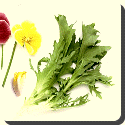 Endive — Endive, Cichorium endivia is a leaf vegetable belonging to the daisy family. Endive can be cooked or used raw in salads.
Endive — Endive, Cichorium endivia is a leaf vegetable belonging to the daisy family. Endive can be cooked or used raw in salads.
The technique for growing endives was accidentally discovered in the 1830s in the Josaphat valley in Schaerbeek, Belgium. Endive is cultivated for culinary use by cutting the leaves from the growing plant, then keeping the living stem and root in a dark place. A new bud develops but without sunlight it is white and lacks the bitterness of the un-blanched foliage. Today France is the largest producer of endives.
Endive belongs to the chicory genus, which includes several similar bitter leaf vegetables. Species include Cichorium endivia, Cichorium pumilum and Cichorium intybus. The former, the endives, includes Belgian endive (witloof) while the latter (Common Chicory) includes chicory cultivars such as Radicchio and Puntarelle. Endive is rich in many vitamins and minerals, especially in folate and vitamin A and K, and is high in fibre.
There are three main varieties of endive: Frisee, curly endive and escarole.
Curly endive (sometimes mistakenly called chicory in the United States) has green, rimmed, curly outer leaves.
Frisee has finely cut, frizzy leaves. Some confusion results from the fact that frisée also refers to a technique in which greens are lightly wilted with oil.
Escarole has broad, pale green leaves and is less bitter than the other varieties.
Belgian endive is also known as French endive and as witlo(o)f in the USA, as witlof (the Dutch name) in Australia, as endive in France and in Francophone parts of Belgium and as chicon in parts of Northern France. It has a small head of cream coloured bitter leaves. It is grown completely underground or indoors in the absence of sunlight in order to prevent the leaves from turning green and opening up (etiolation). The plant has to be kept just below the soil surface as it grows, only showing the very tip of the leaves. It is often sold wrapped in blue paper to protect it from light and so preserve its pale colour and delicate flavour. The smooth, creamy white leaves may be served stuffed, baked, boiled, cut and cooked in a milk sauce, or simply cut raw. Slightly bitter, the whiter the leaf, the less bitter the taste. The harder inner part of the stem, at the bottom of the head, should be cut out before cooking to prevent bitterness.
 Kids Portal For Parents India Kids Network
Kids Portal For Parents India Kids Network






